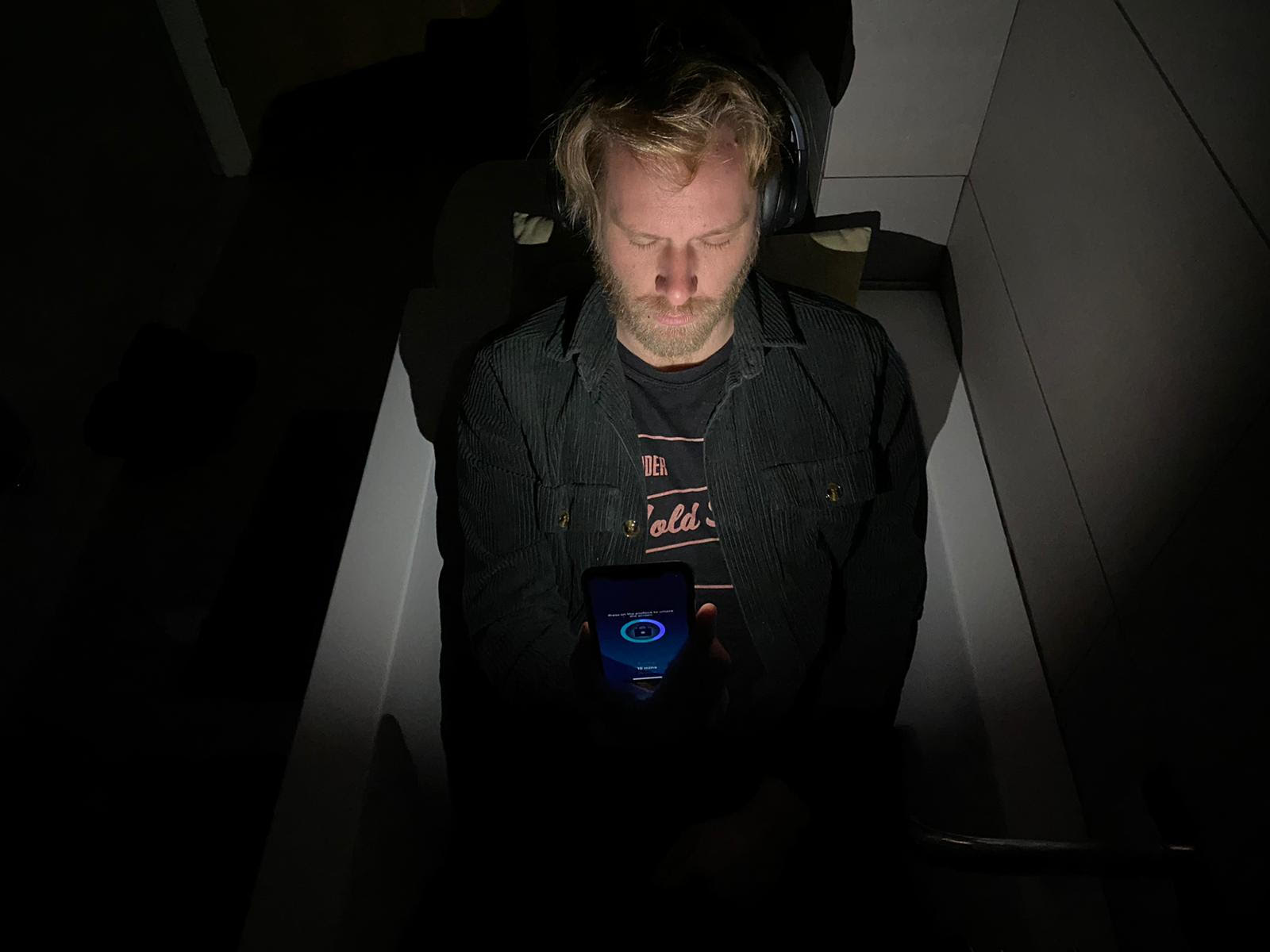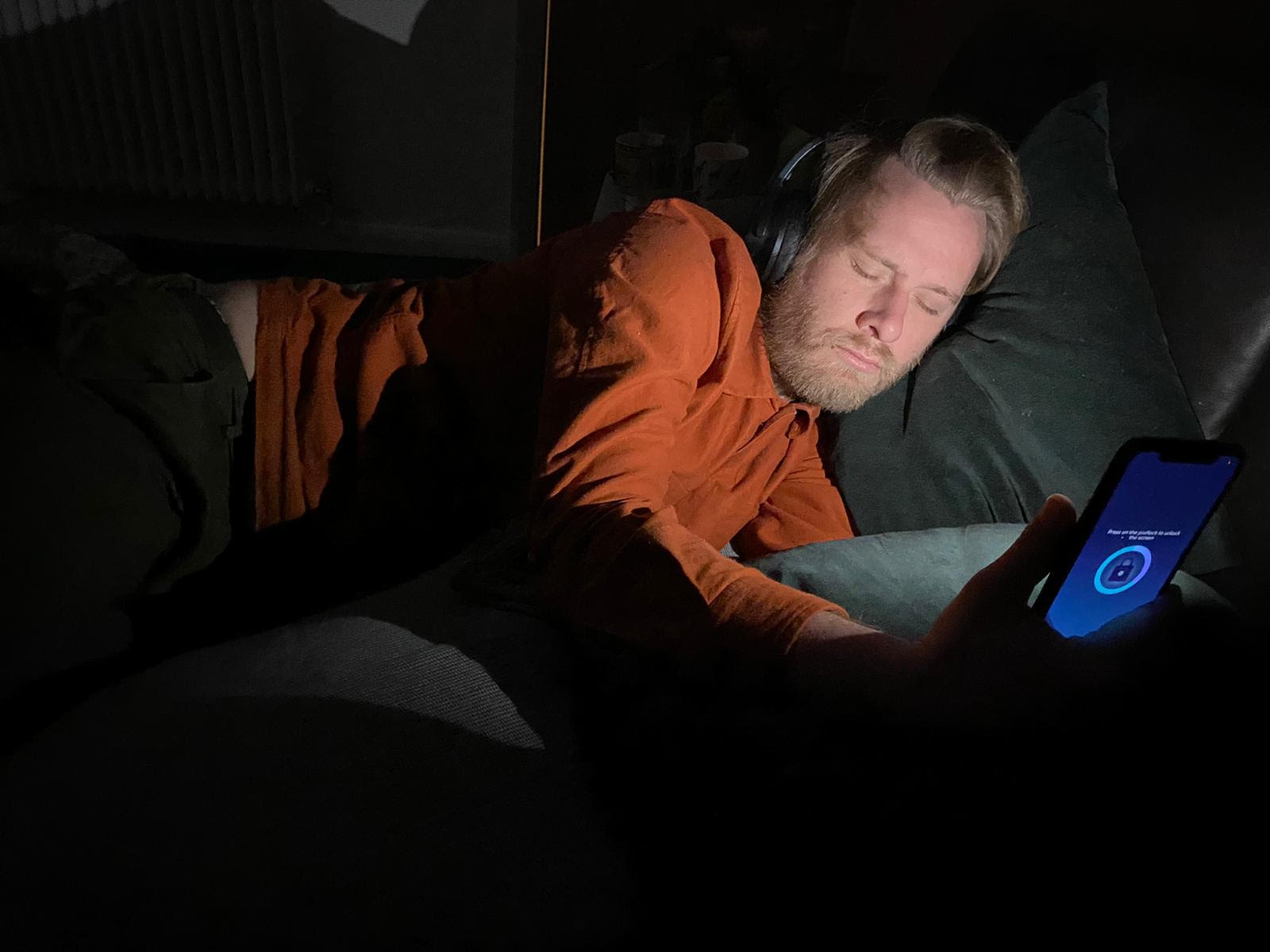Our smartphones allow us to do all sorts of things. We can buy a gun off social media, book a holiday, propose on TikTok or even make a telephone call. But there’s one thing your phone has never been able to do in and of itself: get you high.
Luckily, someone is finally trying to right that wrong. A new phone app called Lumenate claims to alter the brain’s rhythms with a smartphone’s torch, putting users into a state somewhere between psychedelic high and deep meditation – and unlike a seven-hour LSD trip, it can be disengaged in a swipe.
Videos by VICE
So I decided to give it a go. But first, some history.

The concept of using flickering light to alter consciousness isn’t novel. It’s said the prophet Nostradamus received his visions while staring at the sun, while in 1819 the Czech scientist Jan Purkinje recorded visual phenomena as he waved a hand between a gaslight and his eyes.
It was in the early 1960s that the practice of using a stroboscopic (AKA strobe-like) light emerged onto the fringes of the mainstream. The Beat Surrealist artist Brion Gysin and Cambridge scientist Ian Sommerville – encouraged by the Naked Lunch author and alternative culture node William Burroughs – developed the “Dreamachine”. A relatively simple device, it comprised a cylinder with slits in the sides and a suspended lightbulb at its centre, which spun at 78 revolutions a minute on a turntable. Users sat in front of the revolving cylinder with their eyes shut, and hallucinatory montages of colours and shapes exploded behind their eyelids, supposedly inducing a trance-like state.

The Dreamachine debuted at Paris’ Museé des Arts Decoratifs in 1962, with Gysin rather sweetly believing his patented invention could replace television in the international consciousness. Perhaps unsurprisingly, it caught the attention of the era’s psychedelic luminaries, with poet Allen Ginsberg extolling that it “sets up optical fields as religious and mandalic as the hallucinogenic drugs”, and Brave New World writer Aldous Huxley declaring that “the Dreamachine is an aid to visionary experience”.
Despite Gysin’s prediction bearing little commercial fruit, thus began a long history between the Dreamachine and creative figureheads. The likes of Iggy Pop, Kurt Cobain, Genesis P-orridge and Margaret Atwood have all been noted users as they searched for cosmic inspiration or refuge, with Atwood – author of The Handmaid’s Tale – saying “it’s very relaxing and aids lateral think-jumps”.
Lumenate is quite literally carrying the torch, with an app built on the same principles as the Dreamachine – only it’s now a smartphone light that gets you “high”. It was created by the Bristol-based Tom Galea and Jay Conlon, who say they’re “on a mission to make subconscious exploration more accessible than ever before”, and that the app has had over 25,000 downloads since launching on 2nd March. The pair have even secured their own celebrity backing in the form of recent Golden Globe winner Rosamund Pike, who tried the app during its beta phase and found it so impactful that she’s now Creative Director.
Galea says that, in 2019, he and Conlon purchased an EEG machine – a device that measures electrical activity in the brain – and developed the app through hundreds of hours of self-experiments. “At a basic level, as the light flashes the brain also flashes in sync, sending a signal that something’s changing,” he explains, “and gradually that synchronisation with the light spreads through the brain and allows you to send it into the desired state.”
That state is one of elevated consciousness, and the theory goes that Lumenate replicates chemical aspects of the classical psychedelic experience – including increased functional connectivity in the brain and decreased activity in its default mode network.
While this conclusion remains largely theoretical, with academic support in short supply, Lumenate has a relationship with a research team at Sussex University. They conducted an experiment with 19 students in 2019, which found that “stroboscopic stimulation offers a powerful non-pharmacological means of inducing ASC [altered states of consciousness] as well as providing a possible adjunct to psychedelic therapies”.
Lumenate also has the thumbs up and funding from leading lights in the UK psychedelic landscape. Researcher Dr Ben Sessa and members of the psychedelic research team at Imperial College, London have given positive testimonials regarding Lumenate and its potential for therapeutic use, while investment has come from Beckley Waves, which fund companies in the psychedelic ecosystem.
This all suggests that Lumenate has some legitimacy. But how does it work, and precisely how many balls do you trip?
The free app’s onscreen prompts state it’s best experienced in a dark space with headphones, and that alcohol use reduces the intensity (more on that shortly). Over the course of a five-minute taster session, a glacial male voice over some decidedly cosmic keys gives us the light-trip basics: start with the torch an arm’s length from your eyes, then experiment; try to keep your eyes “relaxed”; the visions you’re about to see are unique to you, man.
Depending on the chosen session setting – Lumenate has everything from one-off relaxed “explorations” to a four-part guided series tackling emotional blocks – you’ll likely be concerned with finding calm or something intentionally self-exploratory.
The best way I can describe the visuals? Scrunch your eyes tightly – you’ll likely see a shadowy tableau of fractal light, braiding geometric shapes and perhaps a flashing, Tron-like tunnel that you can follow infinitely. Lumenate is like that, but starkly lit with unrecognisable hues, and laugh-out-loud beautiful at times.

Nevertheless, after the first couple of uses – done in the (unfilled) bath, as the bathroom is the darkest room in my house – I enjoyed the experience, but overall filed it under “interesting” rather than “useful”.
I picked up some tips from the Lumenate Community Facebook group and tried a different setting. Laying on my side in bed, arm propped up with a pillow, I selected the “Choose Your Own Soundtrack” option and settled in for 20 minutes. The music seemingly synced to the visuals, which became both acuter – more mobile, intense and brighter kaleidoscopes – yet ultimately soothing. Despite being slammed with work that day, I felt like I’d spent the afternoon absent-mindedly padding around a hotel spa in a safe world where COVID, violence and anxiety don’t exist.
Under the auspices of Doing Thorough Journalism, I also tried it following a few beers and some wine. It was less visceral, but I absorbed the music in the unbridled, guttural way I did as a teenager. I also fell asleep for nine hours almost straight after – something not to be sniffed at for a man who’s tussled with insomnia most of his life.

As for other drugs, Galea says they’ve heard people say the experience is supercharged by weed (though obviously he can’t vouch for or support this), and a post on the Community group rhapsodises about combining Lumenate with magic mushrooms.
So, what exactly is Lumenate?
Galea says, “We see ourselves as sitting in a space between the wellness world, the meditation world and the psychedelic renaissance space. We’re not saying Lumenate will answer all your problems or questions, but it can be a tool within a wellbeing toolkit.”
I was honestly quite sceptical to start with, but my feeling now is that most people could find a use for Lumenate’s unique brand of solo tripping – whether you’re an anxious city dweller, nu-earth mum or festival scumbag. Whoever thought your phone could fly you into space?
More
From VICE
-

Photo by ALLISON DINNER/EPA-EFE/Shutterstock. -

Photo by Steffi Lopez. -

-


